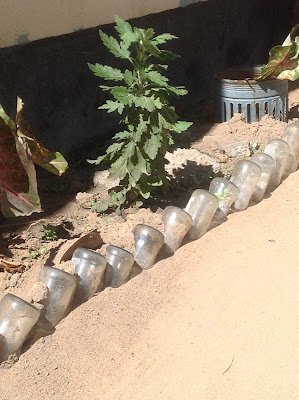 Our three year old, Jonas, was entirely disappointed the first time we went to "the rural areas." Knowing our gardener was from "the rural areas," Jonas expected to be visiting his home. "The rural areas" is actually a term for any area outside of the few large cities that dot the landscape of my African country. But to Jonas it is a confusing concept when a thousand miles looks as big as one!
Our three year old, Jonas, was entirely disappointed the first time we went to "the rural areas." Knowing our gardener was from "the rural areas," Jonas expected to be visiting his home. "The rural areas" is actually a term for any area outside of the few large cities that dot the landscape of my African country. But to Jonas it is a confusing concept when a thousand miles looks as big as one!The Shona people in my country live in a variety of ways, but by far most grow up in "the rural areas." The many Shona who work in the city often place their children back in the rural areas with relatives while they work to make money in the city. This is common because schooling that is $10 per term in the rural areas can cost hundreds, even thousands per term in the city. As a result of this lifestyle, almost all Shona have a rooted, familial connection to the rural areas, where their childhoods took place and where many city workers eventually return to in old age. Here are some details about the Shona homes found in the rural areas of my country:

The typical rural home is either a collection of huts or cement buildings.
Each building acts in the same way a room of a house would function.
The hut that is by far the central hub of the home, though, is the
kitchen.
Some rare homes enjoy the luxury of boreholes. Most (like above) have wells or a place, such as a river, from which to carry water.
Every drop of water is precious in this country, but especially during the dry season between April and September, when rains are almost non-existent. Here Kurt washes his hands before tea.
The Shona culture does not score high on gender equality... the men sit around the edges on benches, chairs, or stools. The women always sit on mats on the floor. Jonas compromises and sits on my lap as we enjoy tea in the kitchen... Here we eat white bread, tea, nyimo beans (a delicious groundnut) and a hard-boiled egg.
The kitchen has gathering space around a central fire pit. Sometimes a cabinet may also be placed in the kitchen, as above on the left. A large wardrobe or cabinet is often a person's most valuable possession. The pots on the walls store a non-refrigerated, fermented dairy product called lactose.
Here our friend Laura smiles as we squeeze in one more person. Sizes of huts vary- this kitchen fit 40 of us in... tightly!!


The most common building material in the country is bricks and mortar or cement. Buildings are almost solely made of these things. Huts, though have floors made of a hardened, dried paste made of a cow dung and water mixture. These floors have to be redone approximately every three years.
One of the most gorgeous things about visiting the rural areas is seeing the way in which every single thing has a purpose and a value. The structure above is a chicken coop.
Chicken coops, even on very affluent homesteads, are often made of found objects that have been welded together.
Above and below, grates have been welded together for this chicken mansion.
Lifetimes before moving to Africa, as an NYC interior designer I studied a philosophy called Wabi Sabi. It's a Japanese aesthetic and world view that is based on the concept that beauty and value come from items that are imperfect, incomplete and often marked from their experiences. The life of the object brings it beauty, not symmetry, cleanliness, or solidity. Never have I found better examples than in my time in Africa.
Here a garden rake and wall grate have been welded with other metals to make a miniature coop.
Love it. Above and below glass bottles are used to line herb beds.
Cattle pens made from collected branches line every rural area landscape.













